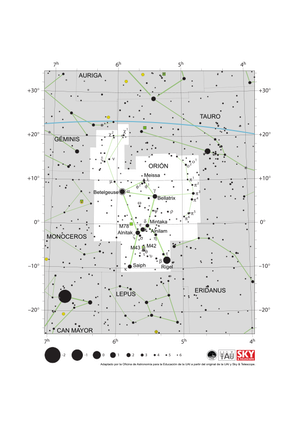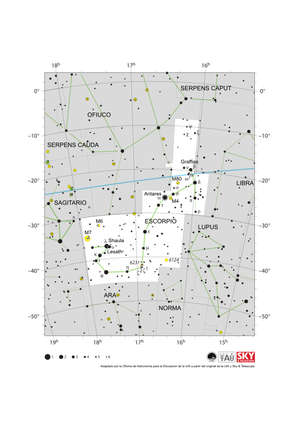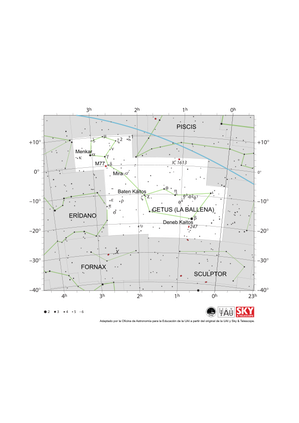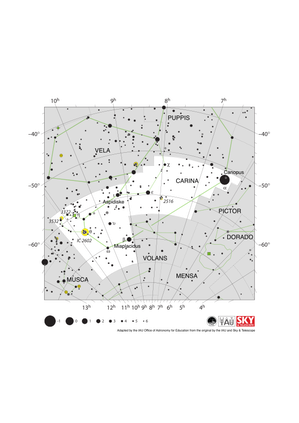Glossary term: Estrella variable
Description: Una estrella variable es una estrella que muestra cambios de brillo marcados a lo largo del tiempo para los observadores. El brillo de todas las estrellas cambia a lo largo de millones o miles de millones de años debido a la evolución estelar. El término estrella variable suele reservarse para las estrellas cuyo brillo varía en escalas de tiempo mucho más cortas que sus escalas de tiempo evolutivas.
Existen varios mecanismos físicos posibles que pueden dar lugar a la variabilidad. Algunas estrellas, como las variables Cefeidas o las estrellas RR Lyrae, son inestables y pulsan, cambiando su tamaño y brillo.
Otras estrellas pueden expulsar material brillante que aumenta el brillo general observado ("variables eruptivas"). Las estrellas denominadas variables cataclísmicas o novas muestran un aumento repentino de brillo seguido de un retorno a su nivel anterior. En este tipo de sistemas, se trata de un par de estrellas en las que la materia de una fluye hacia la otra y se enciende en una reacción de fusión nuclear en cuanto se alcanza un determinado umbral. Una u otra estrella sufre una explosión cataclísmica y aumenta su brillo.
Otras estrellas parecen variables porque rotan y nos muestran alternativamente un lado más brillante y otro menos brillante, o porque en realidad son dos estrellas que orbitan una alrededor de la otra y una de ellas se eclipsa periódicamente detrás de su compañera. Este último tipo de binaria se conoce como binaria eclipsante.
Related Terms:
See this term in other languages
Term and definition status: The original definition of this term in English have been approved by a research astronomer and a teacher The translation of this term and its definition is still awaiting approval
The OAE Multilingual Glossary is a project of the IAU Office of Astronomy for Education (OAE) in collaboration with the IAU Office of Astronomy Outreach (OAO). The terms and definitions were chosen, written and reviewed by a collective effort from the OAE, the OAE Centers and Nodes, the OAE National Astronomy Education Coordinators (NAECs) and other volunteers. You can find a full list of credits here. All glossary terms and their definitions are released under a Creative Commons CC BY-4.0 license and should be credited to "IAU OAE".
If you notice a factual or translation error in this glossary term or definition then please get in touch.
Related Diagrams
Mapa de la constelación de Orión
Credit: Adaptado por la Oficina de Astronomía para la Educación de la UAI a partir del original de UAI/Sky & Telescope
License: CC-BY-4.0 Creative Commons Reconocimiento 4.0 Internacional (CC BY 4.0) icons
Mapa de la constelación de Escorpio
Credit: Adaptado por la Oficina de Astronomía para la Educación de la UAI a partir del original de UAI/Sky & Telescope
License: CC-BY-4.0 Creative Commons Reconocimiento 4.0 Internacional (CC BY 4.0) icons
Mapa de la constelación de Cetus
Credit: Adaptado por la Oficina de Astronomía para la Educación de la UAI a partir del original de UAI/Sky & Telescope
License: CC-BY-4.0 Creative Commons Reconocimiento 4.0 Internacional (CC BY 4.0) icons
Carina Constellation Map
Credit: Adapted by the IAU Office of Astronomy for Education from the original by the IAU and Sky & Telescope
License: CC-BY-4.0 Creative Commons Reconocimiento 4.0 Internacional (CC BY 4.0) icons
Perseus Constellation Map
Credit: Adapted by the IAU Office of Astronomy for Education from the original by the IAU and Sky & Telescope
License: CC-BY-4.0 Creative Commons Reconocimiento 4.0 Internacional (CC BY 4.0) icons













